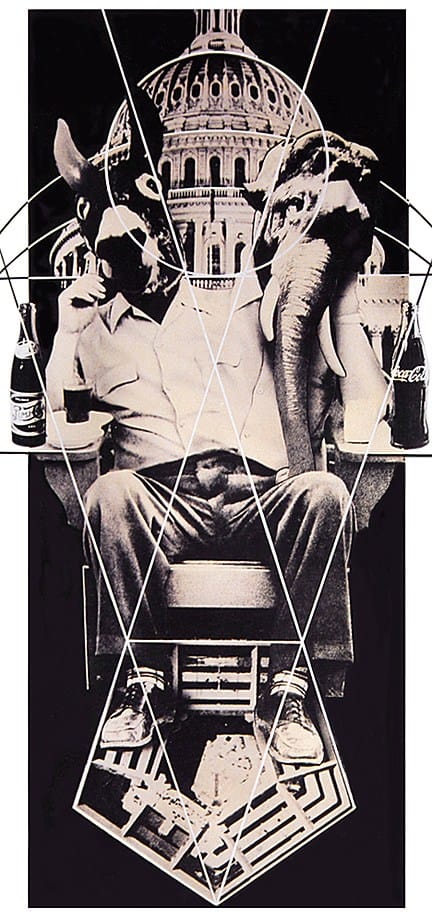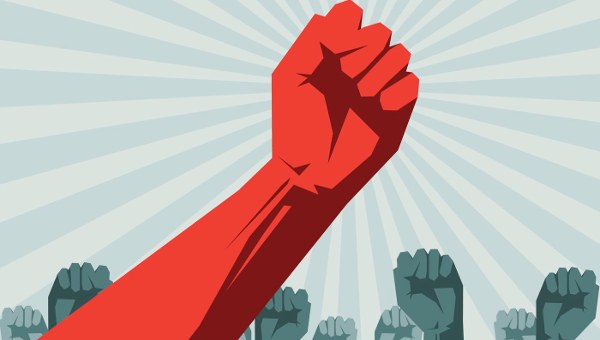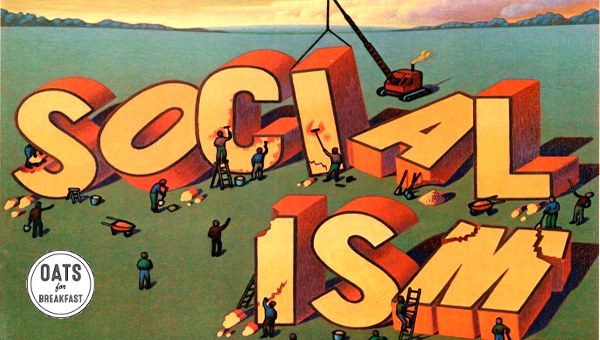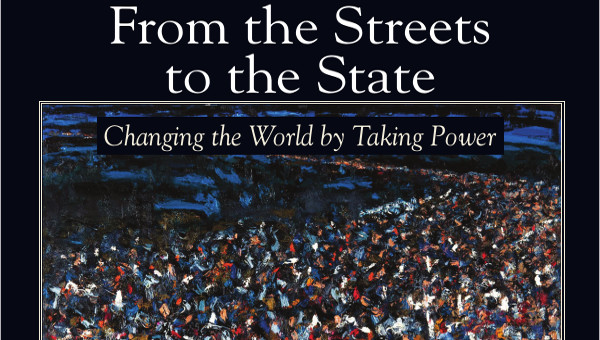«— The State and Socialist Strategy 3 —»
Socialist Strategy and the Capitalist Democratic State
The democratic socialist movement in the United States today is emerging from a central impasse: the dual failure of both social democratic and Leninist politics. Though social democratic parties could once plausibly claim to be pursuing incremental reforms as a path to something better, the contemporary collapse of parties formed from this tradition across the core capitalist countries following their retreat into ‘Third Way’ politics suggests otherwise. Beginning in the 1980s, this retreat included abandoning even rhetorical commitments to class struggle in favor of seeking ‘inclusion’ for marginalized groups within the structures of neoliberal corporate capitalism.

On the other hand, the embeddedness of the contemporary capitalist state within civil society – definitively unlike the situation in Tsarist Russia – makes it hard to imagine a socialist transition taking place through ‘smashing’ the state from outside and organizing a ‘dictatorship of the proletariat’, even leaving aside the dangers of political authoritarianism that come with such an approach. Nor are there any forces on the horizon that could possibly begin to carry out such a program. For these and other reasons, the Leninist call to insurrection does not today appear to offer a viable path forward for the left. So how then should the blossoming socialist movement approach the capitalist state and the question of political power?
Yet there is another way. Running socialist candidates for office, mobilizing social struggles from below, and building the institutional infrastructure of working class power can be mutually reinforcing. We believe that breaking the power of the capitalist class by democratizing the economy and transitioning to a social system organized for the common good rather than private accumulation – in other words, democratic socialism – is possible only by waging a struggle on the terrain of the state linked with a broader ‘political ecology of movements and forces’. Developing such a strategic view requires a theory that clarifies the antagonisms and contradictions within the state, and between the state and social classes.
In what follows, we lay out some essential theoretical and strategic guideposts on the contemporary capitalist democratic state. Though certainly not exhaustive, we believe these serve as crucial analytical foundations for debates within the emerging socialist left. While there is today the potential to develop a genuinely mass socialist politics, this will depend on building organizational forms and strategies that transcend the limits of the models of the past – moving beyond a narrow insurrectionary view of politics and engaging in a struggle on the terrain of the state, while avoiding the trap of a social democratization that serves to simply accommodate workers to capitalism.
Beyond Social Democracy and Leninism
Postwar social democracy saw the state as fundamentally neutral in the struggle between capital and labour, and only subsequently ‘captured’ or won by the stronger side. In this view, there is nothing inherently capitalist about the state: by winning elections, it can become a workers’ state even without transforming its existing institutions or breaking with capitalist production relations. Such a view fails to capture the state’s structural role in reproducing capitalist class power, which goes far beyond electoral contests and outcomes. On this basis, social democratic parties have been organized as top-down structures led by a technocratic elite. They have pursued a strategy of parliamentary centralism, whereby all social constituencies and forces are directed toward the end of winning elections. This electoralism narrows the political horizon of social democratic parties, preventing them from cultivating broader, long-term social movements and struggles, building workers’ democratic capacities, or building mobilizations that risk challenging the party elite.
With the slowdown of capitalist growth in the 1970s, the integration of social democratic parties within the capitalist state, reinforced by their top-down structures, commitment to a politics of class compromise, and marginalization of socialist ideas as unrealistic – in addition to the depoliticization of the labour movement – left them without the ability to push forward an alternative to the neoliberal resolution to capitalist crisis. By the 1980s, they had begun moving toward the market-oriented neoliberal framework with any remaining commitment to class struggle replaced by an emphasis on the inclusion of marginalized groups within the structure of corporate capitalism – even while implementing punitive social and economic policies that disproportionately affected those same groups.
Unlike social democrats, socialists seek to democratize both the means of production and the means of state administration. Doing so requires that both parties and movements, acting in tandem, cultivate extra-parliamentary forces that can push for a deep transformation of political and economic institutions. Rather than merely seeking to win for the working classes a larger slice of the economic pie, socialists seek to fundamentally change how the pie is made: that is, to create a democratic economy that does not rely on authoritarian corporate control over production. Similarly, socialists see struggles to expand the welfare state as a basis to further empower workers, building capacities for broader struggles from below while developing new and more substantial forms of democratic participation.
Accordingly, socialist parties should be organized democratically, encouraging active participation by members in debating and formulating strategies and programs, thereby developing workers’ capacities through struggle. A key task for socialists is to think through what the socialist transformation of society and the state would look like, and strategize and organize to achieve it. For instance, how could a socialist government break with the Federal Reserve’s role in capitalist macroeconomic stabilization to democratize money and finance, and transform the Treasury to move away from its mandate of reproducing capitalism and develop popular planning capacities to coordinate industry and production?
Just as social democrats lose sight of what is fundamentally capitalist about the capitalist democratic state, Leninists have reductively understood it as simply another institutional form of capital. This view treats the state as a unitary, monolithic apparatus without internal contradictions that is superimposed upon society and controlled by a unified capitalist class. Yet conceiving of the state in this way, as a “machine for maintaining the rule of one class over another,” tells us little about how actually-existing capitalist states function, and is not helpful in developing practical political strategy.1 Indeed, this view leads directly to a problematic and implausible call to “smash the state.” This is to take place through a “dual power” strategy, which entails either an insurrectionist politics of building increasingly mobilized confrontations led by a militant “vanguard” minority, regardless of the circumstances or issues at hand, or to utopian attempts to build “common spaces” outside of the reach of capital or the state. Yet today there are no forces on the horizon capable of carrying out this “smashing,” and advocates of such an approach have failed to articulate a credible strategy for organizing these. Even if such forces could be organized, that the state could simply be destroyed is hardly conceivable in contemporary advanced capitalism, in which states are deeply embedded in “civil society” and rely on it to build hegemony through electoral mechanisms, the media, and other ideological institutions.
To take such a view of the state means seeing efforts to decommodify healthcare, expand public services, improve conditions of work and unionization for public sector workers, and many other important struggles for changes to the capitalist state as ultimately self-defeating – merely supplying capital with more docile, healthier, and more content workers for exploitation. For this reason, Leninist organizations have often been hesitant to participate in electoral politics or struggles for reforms to the capitalist state. When they do, they seek to bridge these theoretical contradictions by awkwardly construing this as a tactical step in building dual power and ultimately capturing and smashing the state. In fact, working class struggles for health care, collective bargaining, universal suffrage, and civil, political, and social rights have historically been at the heart of movements to democratize society and win important concessions from the state. There are obvious challenges to our own strategy of socialist transition through a series of ruptures within, against, and beyond state institutions. However, acknowledging these challenges does not in turn make the dual power strategy a more plausible way forward for socialist struggles in contemporary capitalist societies.
By seeing the state as merely an institutional expression of capital, Leninists have framed “smashing the state” as part of the struggle for genuine democracy against capitalist alienation. Dual power institutions like workers’ councils and, more often, the Party itself, are claimed to be unalienated forms of workers’ political power. Though not accepted by all Marxists, Marx’s theory of alienation (as regards the state) is that, rather than appearing as the creation of living human beings and the product of their concrete activities, the capitalist state stands above its creators as an apparently independent, alien force that dominates and attains mastery over them. Moreover, although society is concretely divided into classes, the ideology of the liberal state posits a harmonious, abstract political community comprised of individual “citizens” afforded equal rights under the law. Thus the concrete unequal conditions of existence of the working class are effaced by an abstract political equality.
An important objective of socialists, therefore, has been the dis-alienation of political power and the struggle for a more meaningful form of democratic political organization. Yet it does not necessarily follow from this that the state must be “smashed” in a single blow. Rather, Marx’s theory of alienation implies a conception of democracy as a process of human development through social struggles. Through struggle, the working classes seek to address the processes and means of democratic administration and coordination as problems to be solved. Given that political democracy and universal suffrage were not gifts from above but important legacies of working class struggles from below, continuing and expanding these fights to create new participatory forms of political and economic democracy is the clearest path to creating such a “dis-alienated” form of social organization and governance. This, including organizing new bottom-up forms of workplace and community-based direct democracy, is what is meant by transforming the state. Indeed, as the Bolshevik experience suggests, the imperatives of carrying out a revolutionary program demand the coordination of an active and powerful state – which may result in the rise of an even more alienating form of political authority on the ashes of the “smashed” one.
Moreover, it is crucial to recognize that the capitalist state is not merely an alienated social form, but also a mode of representation. The problem of representation is irreducible in the sense that any state, party, or other institutional locus of political agency must rely on a claim to represent a larger and more diverse and complex constituency. These claims are always open to contestation. Respresentation is inevitably partial: no organization can ever fully represent the constituency whose political agency it seeks to express. To define this problem simply as one of “alienation” is to express a desire for a utopian end to politics – where representation is either unnecessary or unmediated. Paradoxically however, this may result in even more alienating forms of state or party organization. Any organization claiming to fully represent its constituents in an “un-alienated” fashion in fact submits these constituents to itself and its own political agency. Concrete subjects are reduced to their abstract “representative” ideal articulated by the political agency: the essence of philosophical idealism, as well as that of socio-political alienation. The failure to take the question of representation seriously has resulted in organizations governed by self-reproducing leadership slates lacking transparency and democratic accountability, leading to splits over the correct political “line” and scandals.
Rather than wishing away this dilemma, or theoretically obscuring the relations of power that political representation entails, we should seek to clarify these hierarchies and submit them to democratic control to the fullest extent possible. Our goal should be framed not as the end of social and political alienation, but as the attainment of freedom from social and political domination.
A Terrain of Struggle
Against these views, we argue that the capitalist democratic state is not a unitary “subject” but a contradictory relation of power between social forces, much in the same sense that capital is a social relation.2 Being a relation, the state concentrates within itself the active, material forces making up multiple social and class struggles, and articulates them through its institutions.3 These struggles within and between social classes are constituted by the state and traverse its terrain in the form of internal contradictions. Accounting for the concrete role the capitalist state plays in conditioning and organizing the class struggles in which it is embedded makes it possible to conceive of struggles both within and against the state. The upshot of this view is that while there are deep, inherent, structural biases in the institutions of the capitalist state to govern in favor of the reproduction of capitalism, those biases coexist with opportunities for democratic forces to counter-organize within and across its institutions. In this manner, the state provides a terrain on which working class demands can be articulated, fought over, and possibly implemented.
This line of thinking is rooted in a large body of work in the Marxist tradition. As Friedrich Engels wrote in 1895, The Communist Manifesto “had already proclaimed the winning of universal suffrage, of democracy, as one of the first and most important tasks of the militant proletariat.” The subsequent achievement of this, he saw, created new opportunities for further socialist struggle to transform the state – but not automatically. Rather, it was only by joining universal suffrage with class mobilization from below that “transformed it from a means of deception, which it was heretofore, into an instrument of emancipation.” “With this successful utilization of universal suffrage,” Engels concluded, “an entirely new mode of proletarian struggle came into force… It was found that the state institutions, in which the rule of the bourgeoisie is organized, offer still further opportunities for the working classes to fight these very state institutions.” For this reason, “the conditions of the struggle had essentially changed,” and “rebellion in the old style, the street fight with barricades… was to a considerable extent obsolete.”4 Clearly this was not the case in revolutionary Russia – but then, neither was universal suffrage a characteristic of the Tsarist state.
Indeed, Marx and Engels saw in the Communist Manifesto the crucial importance of the struggle for radical reforms – demanding universal suffrage and education, a progressive income tax, the creation of a national bank, and other such measures. Likewise, Marx’s Eighteenth Brumaire not only asserts that the French state was an alien, parasitic body, but sees it as an entity whose institutions absorbed and channelled the balance of forces between social classes toward particular outcomes. Later, Rosa Luxemburg advanced a similar view in her sophisticated conception of how parliamentary struggles can complement and reinforce the building of extra-parliamentary movements and forces, as well as how fighting for reforms within capitalism can build the power and democratic capacities of the working classes to bring about a revolutionary transition to socialism. As she saw, these extra-parliamentary forces are not simply subordinated to parliamentary tactics, but substantially autonomous from them, and even able to push struggles within the state in more radical directions while also waging broader struggles in society.5 Gramsci likewise observed that the “war of maneuver” to “smash” the liberal-democratic state apparatus presupposes a longer ideological and mobilizational “war of position” within the trenches of civil society.6 Rather than seeing the state as simply a machine of domination to be smashed from outside, the strategy that emerges from these thinkers is to see it as a terrain of struggle on which the relations of power can be modified and transformed.
However, while it is a terrain of struggle, the capitalist state is hardly a neutral playing field. The capitalist democratic state is relatively autonomous from the immediate interests of the capitalist class and class fractions, but nevertheless remains defined fundamentally by its function of reproducing capitalism – stabilizing markets, dealing with crises, and reproducing the capital relation whereby labour is commodified. While gains may be won on the terrain of the state, the logic of its reproduction means that these will have to be continually defended by forces within and outside the state. This is another reason why social democratic gains alone will never suffice: they will face continuous political and economic pressure to be rolled back or restructured, even as social democratic parties lack the means to build the mobilizations necessary to defend them, let alone press forward a broader and deeper socialist transformation.
The main task of the capitalist state in securing the reproduction of capitalism is to organize the different fractions of the capitalist class into a hegemonic coalition (power bloc), and to prevent a similar organization on the part of the working classes. The capitalist state, in other words, organizes the capitalist class and disorganizes the working class. Competition places different firms and fractions of the capitalist class at odds with one another. Individual capitalists are concerned with the bottom line of their particular firm, and not with the stability of the system as a whole. As a result, the capitalist class cannot rule directly. The state must stabilize and consolidate these inter-capitalist struggles into a ruling consensus through its political apparatuses (parties, the bureaucracy, legal institutions), economic apparatuses (central banking institutions, monetary apparatus, fiscal policy), and ideological apparatuses (the media, educational institutions). Simply put, the capitalist democratic state is compelled to act in the long-term, general, political interest of the capitalist class taken as a whole, even if against the particular economic and political interests of one or another class fraction.
Yet in order to do so, the capitalist democratic state must enjoy a degree of relative autonomy from the particular firms and specific class fractions among which it seeks to organize an “unstable equilibrium of compromise.”7 This relative autonomy varies across different political formations and historical moments, largely depending on the dynamics of class struggle and the capacities of state institutions at a given point in time. In periods of heightened class struggle, such as during the New Deal era in the United States, the state may be compelled to make political compromises not desired by significant sections of the capitalist class in order to secure stability and order. However, relative autonomy remains a structural, not coincidental, feature of the capitalist democratic state. In commanding the means of administration, and the material and coercive resources necessary to manage the crisis-prone and contradictory capitalist system, it forms the center around which the power of the dominant fractions of the capitalist class is consolidated. In this way, the capitalist democratic state articulates the general balance of forces between and within social classes, rather than being under the direct control of individual capitalists or even the capitalist class as a whole.
Contradictions Within the State
The capitalist democratic state is traversed by the contradiction between its role in reproducing the class relations for capital accumulation, and its role as the face of political legitimacy and popular representation. The relative autonomy of the capitalist democratic state requires it to undertake two key – and contradictory – tasks. On one hand, the capitalist democratic state must create the social conditions that are necessary for the success of accumulation. These include the ongoing commodification of labour, goods, and services; investment in public infrastructure, education, and housing; taxation; and public order through juridical and repressive means. On the other hand, the capitalist democratic state must also legitimate these social relations by ideological means – reproducing notions of popular sovereignty and “the people,” juridical-formal equality and legality, the nation, and “the public interest.” This representation of formal equality stands in a tension with the exploitative and inegalitarian social relations that are shared by all capitalist social formations.
The contradiction that results from this dual pressure, between accumulation and legitimation, runs through the capitalist democratic state. In power, social democratic parties have had to balance this contradiction. The various pressures stemming from capital accumulation – the need to maintain “business confidence,” avoid capital flight, maintain adequate levels of investment, and generally prevent a downturn in citizens’ living conditions – have imposed multiple formal and informal veto points on social democratic parties and state managers. Similarly, austerity measures meant to create favorable conditions for investment also undercut the state’s legitimating function. Partly as a result of these pressures, recent decades have seen the convergence of conservative and social democratic parties around neoliberal modes of governance; the rise of new anti-establishment “populist” ideologies in responses to the technocratic neoliberal management of state economies and bureaucracies by mainstream parties; and the retreat of the state administration into clandestine networks of power relatively insulated from public and legislative oversight.
As we have seen, the structure of the capitalist democratic state – and the fact that it remains embedded within capitalist production relations – means that it is never a neutral terrain between classes; its relative autonomy fundamentally favors the organization of the capitalist class over the working class. The state could only become a “workers’ state” if it were to become a vehicle for fundamentally transforming the capitalist relations of production, or for managing a socialist mode of production. However, material and political concessions within capitalism can be won on the terrain of the state that enhance both the quality of life and expand the political capacities of the working classes. Because the legitimacy of the capitalist state depends on its ability to absorb and ameliorate the demands of working class struggles, these can have an impact on its institutional and material makeup. Historically, this institutionalization of working class struggles has taken the form of corporatist arrangements (trade unions, social welfare provisions) that have mediated between labour and capital, but have not transformed the relations of production, altered the capitalist nature of the state, or disrupted the ongoing commodification of labour power.
At the same time, because the capitalist democratic state is not directly controlled by the capitalist class, it condenses within itself the class struggles and social contradictions of capitalist society, and in doing so it provides certain spaces for organizing on its terrain. Because social struggles are always fused and articulated through state institutions, struggles both outside and within the state can resonate and open new spaces for significant victories. In moments when the contradictions between accumulation and legitimacy come to the forefront, the working classes can intervene to challenge the co-dependence of capital and the state. Combining pressures from extra-parliamentary mass movements outside the state and strategic opportunities from within the state can build the mobilizational capacities of the working classes, expand the scope of democratic practices reproduced by state institutions, and facilitate the development of new forms of bottom-up decision-making and social planning. Even as they are implemented on the state’s biased terrain, these political and social struggles can nevertheless place pressure on the state’s internal contradictions, winning meaningful gains and opening opportunities for further advances – with the ultimate goal of transforming the state and democratizing the economy.
The Transformation of the State
The most plausible path to socialism today is not through a single break, but a series of ruptures. As the strategic theory of the capitalist democratic state outlined here suggests, we can achieve this only by developing the power and democratic capacities of the working classes through a program of radical demands and political interventions on the terrain of the state, with the ultimate aim of a socialist transition. Given the weakness of the left and working class organizations, today the crucial question is not reform or revolution, but rather how to implement changes that are both robust enough to withstand the pressures of global neoliberalism and able to create openings for qualitatively new victories. Socialism could hardly result from the activities of a small, if militant, minority. Nor are sporadic and “spontaneous” upsurges of disorganized resistance and protest sufficient to build the lasting working class power necessary for such a transition. If we are to have socialism, it will be because the great majority of the working classes have been convinced that it is possible and necessary, and are willing and able to fight to achieve it.
Far off as it may seem today, putting socialism seriously on the agenda, let alone achieving a socialist revolution, requires patiently educating, agitating, and building socialist organizations deeply rooted in the working classes. This will entail a long process of building collective capacities and winning reforms that point toward a different way of living, working, and playing. Likewise, such reforms cannot be sustained without revolutionary ruptures.
We thus believe that a mass-based, democratic, ruptural strategy, grounded in a more sophisticated theorization of the contemporary capitalist state, is the most realistic way to think about the transition to socialism. This will entail fighting on two fronts. The first by building a democratic working-class movement outside of state institutions. The other by simultaneously putting pressure on the contradictions inside the capitalist state in order to modify the balance of forces within it and expose it to further popular interventions. Such a political strategy requires both deploying tactics that engage with the state on its own terrain (elections, democratization of bureaucratic institutions) and those that seek to challenge and fundamentally transform the nature and scope of that terrain (extra-institutional social movements, new participatory initiatives and processes including economic democracy and worker self-management). Similarly, socialist electoral victories create opportunities to further involve workers in the political process while building greater capacities for mobilization and organization at the workplace, in the community, and across the country.
The struggle to transform and democratize the state is also indispensable for democratizing the economy. Indeed, even the modern multinational corporation that is the primary institutional means for organizing capitalist production and investment is constituted in and through state power. Constructing the new regime of democratic economic planning that would be at the core of a socialist society requires either organizing new state capacities and institutions, or fundamentally transforming its existing institutions. Even beginning this process requires working within and against the capitalist state. For instance, repurposing factories in the U.S. midwest abandoned by General Motors to produce green technologies requires a massive program of new investment to retrofit existing machinery and technologies and to retrain workers. Nor should a socialist program be targeted merely at assets that capital has abandoned and doesn’t want. We shouldn’t merely focus on taking over failed industries, but on socializing the commanding heights of the economy and the most successful enterprises. Moreover, it is difficult to envision a credible path to the democratization of the financial system other than as part of a project of socialist transition through transforming the state. How else can socialists accomplish this apart from nationalizing major banks, and developing public, participatory institutions for the democratic planning of investment?
Successfully undertaking these tasks of working class formation and state transformation requires developing a socialist party as a crucial mechanism. Yet a party can only be effective if it can establish meaningful and dynamic links with social movements and community and labour organizations that are not merely subordinated to its dictates. Nor is a single organization or political party sufficient to represent a diverse working class. Socialist parties must draw on, engage, and channel the many movements and struggles (anti-racist, feminist, ecological, and others) that are generated within “civil society” – but resist the temptation to substitute itself for them at the earliest convenient moment. The process whereby socialist organizations and parties take shape, and the ways they relate to one another and to other organizations, forces, and constituencies, are today open questions, with few models from the past to rely on. The long, patient process of organizing a socialist movement, in other words, will be subject to immense uncertainty and considerable experimentation.
What is certain, though, is that waging a struggle within and against the state demands that we build new forms of democratic participation and working class organization with the goal of breaking definitively with capitalist production relations and forms of political authority. This process will occur in fits and starts. It will neither be a single, clean break with the existing order nor a smooth evolution from capitalism to socialism. Instead, it will undoubtedly take different forms, and involve an uneven process of periodic re-consolidation of political forces and past victories. In turn, this will require more specific and situated analyses as the movement develops and struggle unfolds. This, after all, is what Marx meant by the “unity of theory and practice”: theory is not ossified dogma, it is rather a tool for analyzing concrete situations, framing debates, and guiding strategy. Navigating between a reflexive anti-statism and the fallacy of attempting to “occupy” state institutions without transforming them is undoubtedly challenging. But only in this way can we advance beyond the past shortcomings of both dual power and social democratic approaches to the capitalist state. •
This article first published on the Verso website.
Endnotes
- Vladimir Lenin, “The State: A Lecture Delivered at Sverdlov University,” 1919.
- Karl Marx, “The Nature and Growth of Capital,” in Wage Labour and Capital; Karl Marx, Capital, Vol. I, Ch. 33.
- Nicos Poulantzas, State, Power, Socialism, 1978.
- Friedrich Engels, 1895 Introduction to Karl Marx, “Class Struggles in France.”
- Rosa Luxemburg, “Reform or Revolution,” 1900; “The Mass Strike”, 1906; and “The Socialization of Society,” 1918.
- Antonio Gramsci, “State and Civil Society” in Selections from the Prison Notebooks, p. 238-239.
- Nicos Poulantzas, Political Power and Social Classes, 1973.





